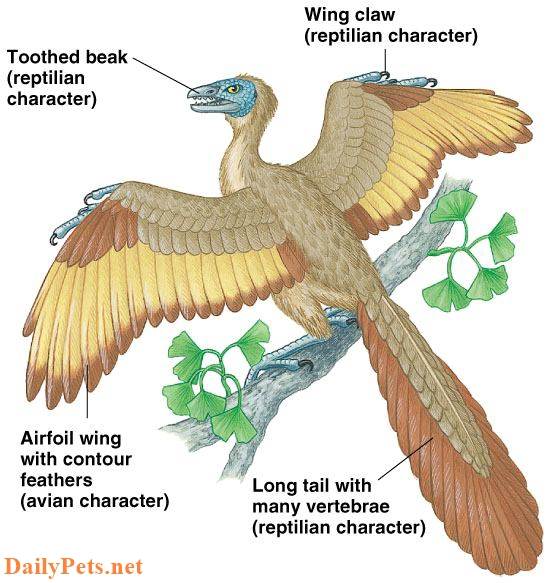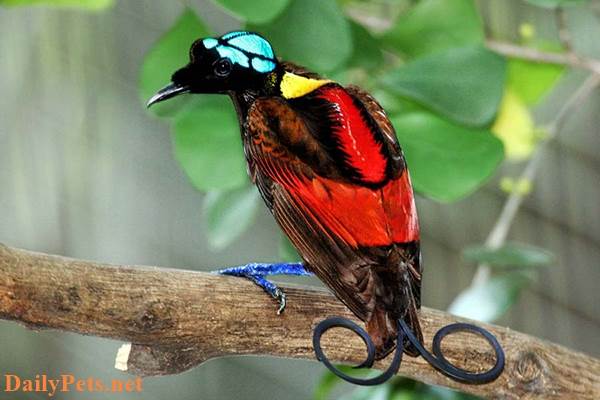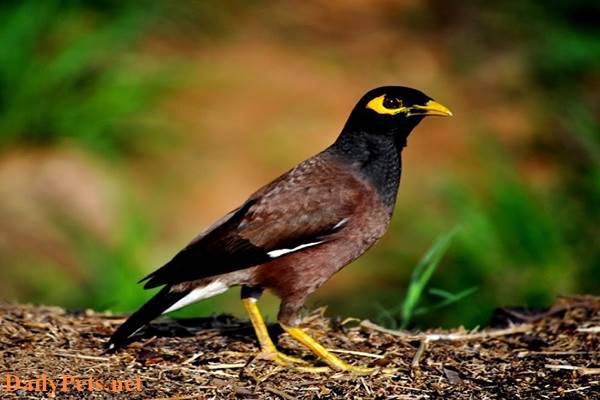These criteria might include factors like vibrant plumage, unique markings, interesting behaviors, and popularity among bird enthusiasts.
Some birds are famous and commonly considered beautiful bird species include:
Bohemian Waxwing
The Bohemian Waxwing is a medium-sized avian species distinguished by its crested head and a notable black mask. Its coloration is primarily grayish-brown, complemented by cinnamon-toned under-tail feathers and yellow-tipped tails. The red edges of its feathers enhance the beauty of these perching birds.
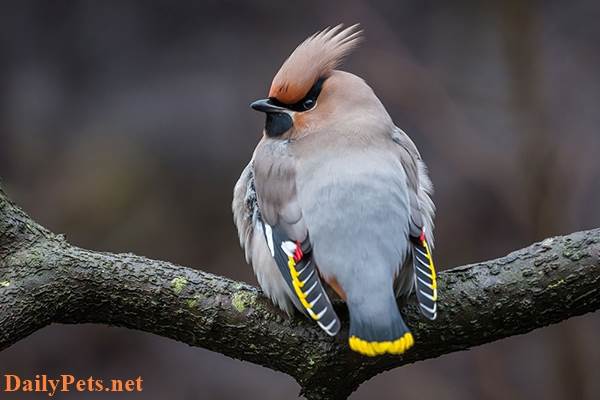
The bohemian stands out among the trio of existing waxwing species, including the cedar waxwing and the Japanese waxwing. Notably larger than the cedar species and rarer than its counterparts, it is widely considered the most aesthetically pleasing member of the waxwing family.
Native to North America, the Bohemian Waxwings inhabit boreal forests, where they build their nests on tree branches. Their diet consists of small insects and fruits. These beautiful migratory birds form extensive flocks during winter, venturing into the northwest United States.
Hyacinth Macaw
Recognized as the “blue macaw,” the Hyacinth Macaw’s stunning azure blue plumage is adorned by a distinctive yellow eye ring. This avian marvel holds the title for the largest flying parrot species, boasting an impressive 40-inch length.

With a wingspan stretching to four feet, its captivating appearance is not solely attributed to its remarkable coloring. The arched black bill and gracefully elongated tail further characterize the Hyacinth Macaw.
Native to the Amazon region, particularly the grasslands of Brazil, this exquisite bird’s population is regrettably dwindling due to hunting and habitat loss. With only around 5,000 individuals remaining in the wild, efforts to protect this species are crucial. Although they can make affectionate pets with proper training, these birds can still deliver a powerful bite and exhibit noisy behavior, especially in groups. Unlike some parrots, they are not prolific imitators of human speech.
Wood Duck
Renowned as one of the most captivating aquatic birds globally, the Wood Duck frequents streams and marshes across the United States and Canada.
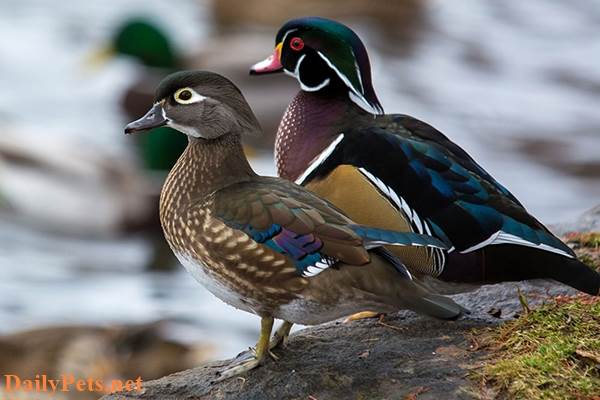
The male Wood Duck outshines its female counterpart with its iridescent green head, crowned by a purple-tinged crest. Elegant white stripes grace their necks, adding to their allure.
The Wood Duck’s plumage plays a dual role in attracting mates during breeding, exhibiting a captivating blend of black and blue patterns. A crimson chest and a white underbelly complete the male Wood Duck’s striking appearance.
In contrast, the female Wood Duck possesses a more subdued brown head and whitish belly embellished with white markings on the chest. Lacking the ability to excavate their nesting holes, these distinctive, beautiful birds often seek refuge in human-made structures, offering a rewarding sight for aspiring birdwatchers.
Keel-billed Toucan
The Keel-billed Toucan instantly captures attention with its extraordinary bill, measuring 7 inches in length. This oversized, multicolored feature has earned the moniker “rainbow-billed toucan,” boasting red, green, and yellow hues.
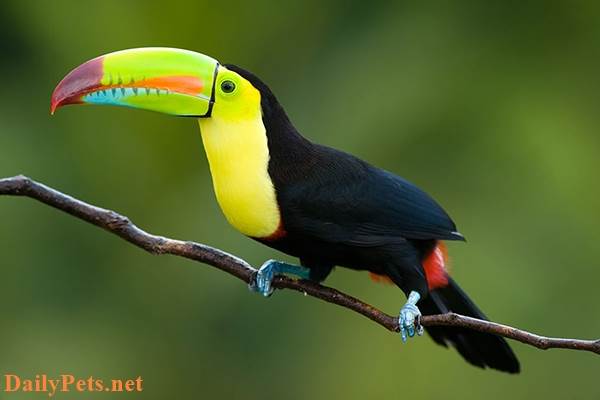
Despite its seemingly weighty appearance, the bill is surprisingly light and hollow. This vibrant beak serves in courting and self-defense during the breeding season.
Sporting predominantly black plumage, the Keel-Billed toucan showcases vibrant yellow feathers on its neck and breast, while its face presents a captivating fusion of green and yellow. The red under-feathers on the tail add the finishing touch to its distinctive elegance.
Enthusiastic birdwatchers seeking this species should venture to South and Central America’s tropical and subtropical rainforests, specifically areas such as Venezuela, Colombia, and southern Mexico. These toucans are most active during dawn and dusk, offering optimal viewing opportunities.
Due to its robust wings, the Keel-Billed toucan is not an agile flyer, often relying on short hops between tree branches. These social beautiful birds typically travel in small flocks ranging from six to twelve individuals, occasionally growing to around thirty birds. They nest in naturally occurring holes or those created by woodpeckers and communicate through distinctive frog-like calls. Their diet encompasses insects, fruits, lizards, and eggs.
Blue Jay
Blue Jays possess elegance and intellect and stand out as some of the most intelligent avian creatures worldwide. Their distinctive “Jay Jay” calls make them easily recognizable. These beautiful birds exhibit vibrant plumage, skillfully combining shades of blue, black, and white.
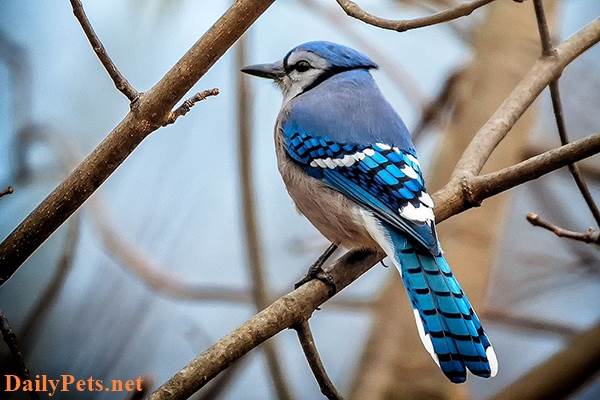
Renowned for their cognitive abilities, Blue Jays are capable of mimicking the calls of other birds. For instance, they can imitate hawk sounds to deceive other avian species. In captivity, they’ve been known to replicate human speech and even mimic the sounds of other pets. Their cleverness extends to tactics such as pilfering eggs and nestlings from other birds.
These birds inhabit woodlands across a significant portion of North America, primarily in the eastern and central regions.
Though naturally inclined to small groups, Blue Jays can assemble into extensive flocks of hundreds when migrating southward for the winter.
Scientists have yet to comprehend the migratory patterns of Blue Jays fully. Some individuals opt not to migrate during winter but remain in their native habitats. Furthermore, consistent migratory behavior has not been observed in all Blue Jays.
Atlantic Puffin
The Atlantic Puffin presents a captivating blend of traits that culminate in one of the most remarkable seabird species. Their plumage bears resemblance to the beloved penguin, yet their distinct bills have earned them the moniker “sea parrot.”

Featuring water-resistant feathers, Atlantic Puffins excel in swimming both on the surface and beneath the water. They employ wing flapping for propulsion underwater and on the surface. Remarkably skilled divers, they reach depths of up to 160 feet. Unlike penguins, they are proficient flyers, achieving speeds exceeding 50 miles per hour.
Enthusiasts of avian observation can locate these splendid beautiful birds along the coast of eastern Canada and the northern USA.
During the summer and spring, Atlantic Puffins breed in nests constructed along the coast. Female puffins lay a single egg, which hatches within six weeks. The chicks are nourished with small fish captured and transported in the birds’ sizable beaks. Astoundingly, a puffin can carry up to 30 fish at once, with staples including hakes, sand eels, and capelins.
Peacock
The Peacock has earned global renown for its remarkably captivating array of tail feathers. Admired by royalty and aristocracy, the Peacock’s allure has extended to all corners of the world, and it holds the esteemed title of India’s national bird.

The Peacock’s allure is highlighted by its resplendent plume train of 150 gorgeously colored feathers. Complementing this display are the charming “Peacock eye spots,” which become visible during these grand exhibitions.
Among the most elaborate mating displays in the animal kingdom, male Peacocks court female peahens through a romantic dance. This includes the majestic shaking of their stunning feathers accompanied by rustling sounds. After the mating season, males shed their ornamental feathers, which regrow within a few months.
Tail length and the number of eyespots vary among individual Peacocks. Peahens tend to favor mates with longer tails and more eyespots. The tail presents a vibrant spectacle that shifts in color based on the angle of illumination.
Peafowls comprise three primary species: the Indian, Congo, and green fowl. The Indian species, in particular, holds global prominence.
Flamingo
Did you know that there are more artificial Flamingoes than real ones? These beautiful birds are beloved for their remarkable beauty and are arguably one of the most easily recognizable avian species worldwide.
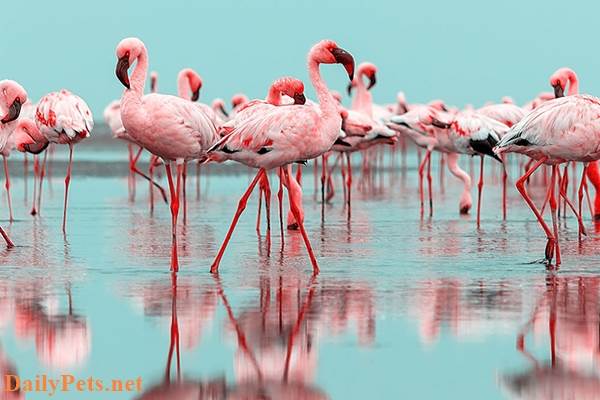
Their stunning pink plumage adds to their captivating charm. Flamingos, categorized into six distinct species often challenging to differentiate, are wading birds. These tropical creatures inhabit every continent except Antarctica.
They can be found across South and Central America, the Middle East, India, Africa’s Rift Valley Lakes, Australia, and more. The Bahamas has bestowed upon the Flamingo the honor of being its national bird.
Flamingos are water-dwellers, thriving in environments like lakes and lagoons. They feed on fish, brine shrimp, plankton, blue-green algae, and larvae found in mud. These beautiful birds are born gray or white and gradually adopt pink or red hues due to the pigments in their diet. The vibrancy of their plumage is indicative of their diet quality.
Remarkably, Flamingos are monogamous creatures that form lifelong partnerships. They congregate in sizable flocks, known as a flamboyance. Flamingos can reach up to 50 inches in length and weigh as much as 7.7 lbs.
Golden Pheasant
The Golden Pheasant would undoubtedly emerge as a top contender in a hypothetical avian beauty contest, likely securing victory. Renowned for its resplendent red and golden-yellow plumage, it unequivocally ranks among the world’s most stunningly beautiful birds.
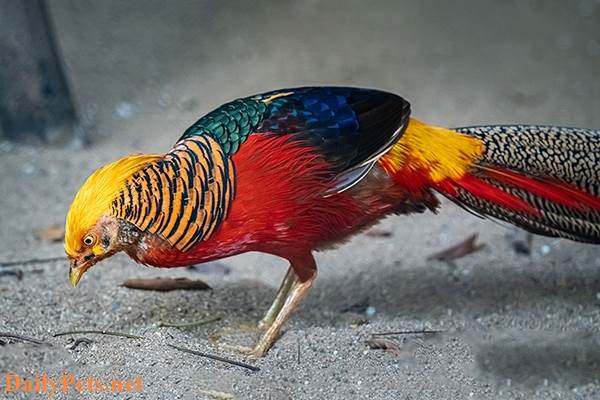
Following the pattern of their fellow pheasants, the males exhibit a greater flamboyance, showcasing vibrant plumage that captures attention. Males sport distinctive crimson flanks and breasts, while females adopt a more subdued brown feathering. The majestic tail, constituting around two-thirds of the bird’s length, is a defining feature of the Golden Pheasant.
The Golden Pheasant dons a regal golden wattle and a verdant upper back, crafting a jewel-like appearance within the Asian wilderness. Preferring the forest floor due to limited flying capabilities, they occasionally engage in brief aerial ventures. Their diet primarily consists of shrubs, berries, and small insects.
These avian wonders inhabit woodlands and mountainous forests across western and central China, where they hold symbolic significance. Additionally, they can be spotted in regions of New Zealand, North and South America, Australia, and Western Europe.
Zoologists have unveiled that the vivid plumage of Golden Pheasants may fade if exposed to prolonged direct sunlight. Hence, to preserve their vibrant colors, they seek refuge beneath the sheltering canopies of the forest.
Scarlet Macaw
Inhabiting the lush tropical rainforests of South and Central America, the Scarlet Macaw emerges as an epitome of avian beauty.

Distinguished by its striking red plumage, the Scarlet Macaw boasts a contrasting cobalt blue back. Its upper wings showcase alluring yellow feathers accented with hints of green, while the lower wings exhibit a captivating fusion of blue and yellow.
Scarlet Macaws effortlessly crack open resilient nuts using their remarkably robust, curved beaks, akin to how we devour crackers. The top of their back features a light tan shade with a black base and tip, augmenting their distinctive allure.
Thriving in the wild for 40 to 50 years, Scarlet Macaws enjoy remarkable longevity, a span that extends to an astonishing 75 years in captivity. Upon maturation, their weight can reach up to 2.2 lbs.
For those captivated by these splendid marvels of nature, the forests of southern Mexico, Bolivia, Peru, Trinidad, and eastern Brazil offer prime birdwatching opportunities.
Recognized for their intelligence, Scarlet Macaws can grasp sounds and words and even respond to human emotions. They exhibit the ability to discern patterns, shapes, and colors when properly trained, exemplifying the fusion of beauty and intellect.
However, prospective pet owners should be forewarned: Scarlet Macaws are known for their vocal nature and can be noisy.
